
Melocactus azureus is a species of cactus. It is endemic to Brazil, where it is known only from Bahia. It is locally abundant but the populations are fragmented and vulnerable to habitat degradation.
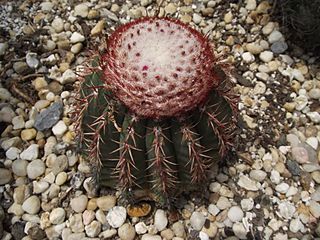
Melocactus conoideus is a species of plant in the family Cactaceae. It is endemic to Brazil. Its natural habitat is dry savanna. It is threatened by habitat loss. It is a species of cacti that originates in Vitória da Conquista, located in the southwestern portion of the state of Bahia, Brazil. This species of cactus was discovered by the German émigré Leopold Horst. This species spreads by bearing fruit with seeds that ants take and transport to other locations that it can grow.

Melocactus deinacanthus, also known as the Wonderfully Bristled Turk's-Cap Cactus is a species of plant in the family Cactaceae. It is endemic to Brazil. Its natural habitat is rocky areas. It is threatened by habitat loss.

Melocactus glaucescens is a species of plant in the family Cactaceae. It is endemic to Brazil. Its natural habitats are rocky areas and hot deserts. It is threatened by habitat loss.

Melocactus lanssensianus is a species of plant in the family Cactaceae. It is endemic to Brazil. Its natural habitats are rocky areas and hot deserts. It is threatened by habitat loss.
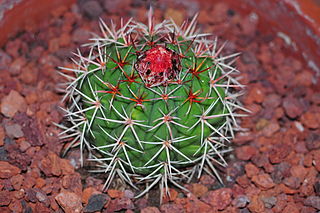
Melocactus pachyacanthus is a species of cactus. It is endemic to Brazil, where it is known only from two locations in Bahia. Its populations are fragmented and it is vulnerable to habitat degradation.

Melocactus paucispinus is a species of cactus. It is endemic to Brazil, where it is known only from Bahia. Its populations are scattered in sand and gravel substrates.
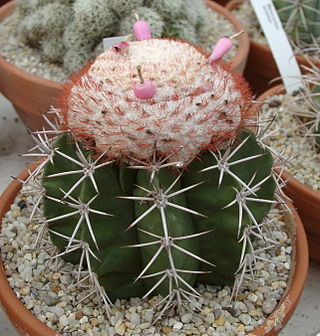
Melocactus violaceus is a species of plant in the family Cactaceae. It is endemic to Brazil. Its natural habitats are dry savanna and sandy shores. It is threatened by habitat loss.
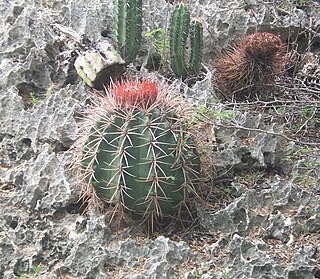
Melocactus caroli-linnaei is a cactus found in Jamaica. When mature it is columnar, up to 1 m (3.3 ft) high. Like all species of Melocactus, it forms a "cephalium" when mature – a dense mass of areoles covered with wool and spines at the tip of the stem. Flowers are produced only from the cephalium.

Mirabella estevesii, synonym Cereus estevesii, is a species of columnar cactus found in Minas Gerais, Brazil. The first description was published in 2004 by Pierre Josef Braun as Cereus estevesii.
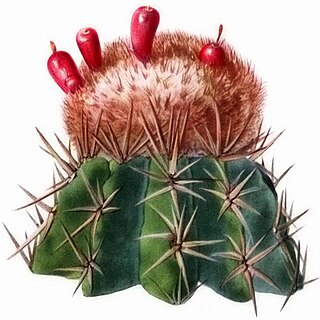
Melocactus lemairei is a species of cactus endemic to the Caribbean island of Hispaniola. It is named after French botanist and cactus expert Charles Antoine Lemaire.
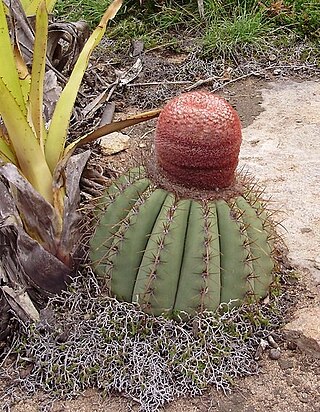
Melocactus ernesti is one of the Turk's cap cacti, and is native to Bahia and Minas Gerais States, Brazil.

Melocactus bahiensis is a species of Melocactus found in Bahia, Brazil.

Brasilicereus estevesii is a species of Brasilicereus found in Brazil.

Melocactus bellavistensis is a species of Melocactus found in Ecuador and Peru.

Melocactus braunii is a species of Melocactus found in Brazil.

Melocactus harlowii is a species of Melocactus found in Cuba.

Melocactus levitestatus is a species of Melocactus found in Brazil.
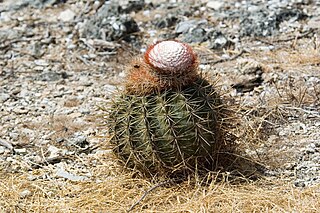
Melocactus macracanthos is a species of Melocactus found in Aruba.
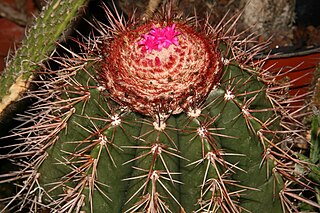
Melocactus oreas is a species of Melocactus found in Brazil.





















